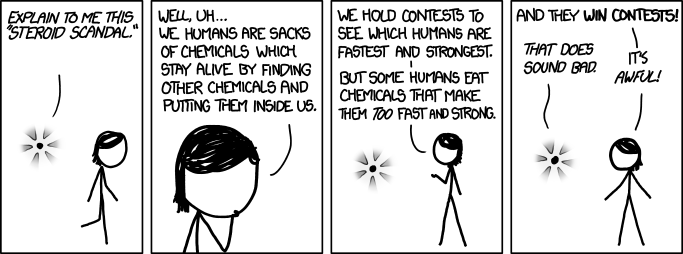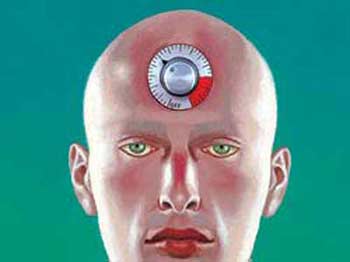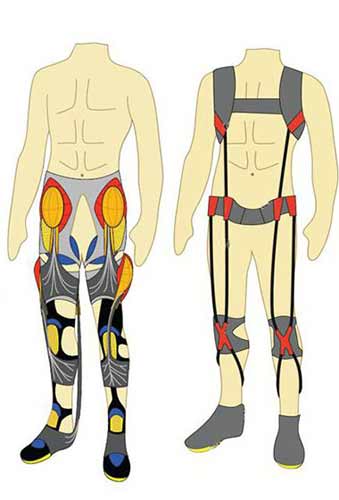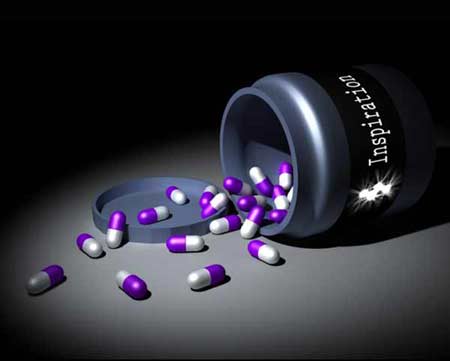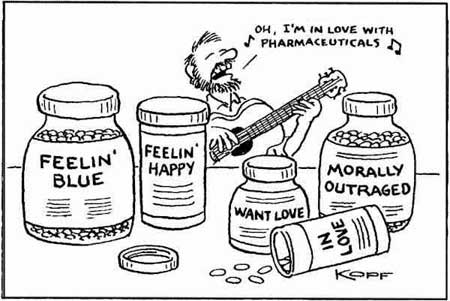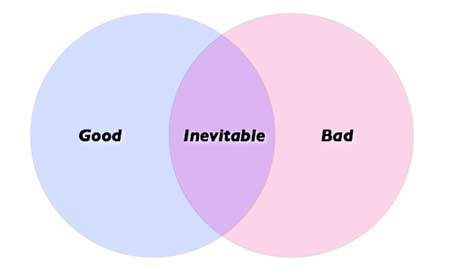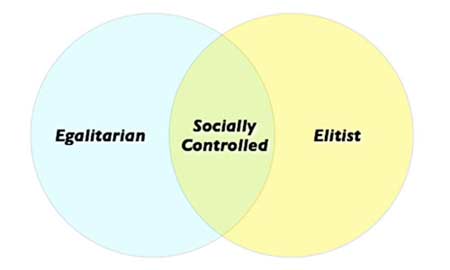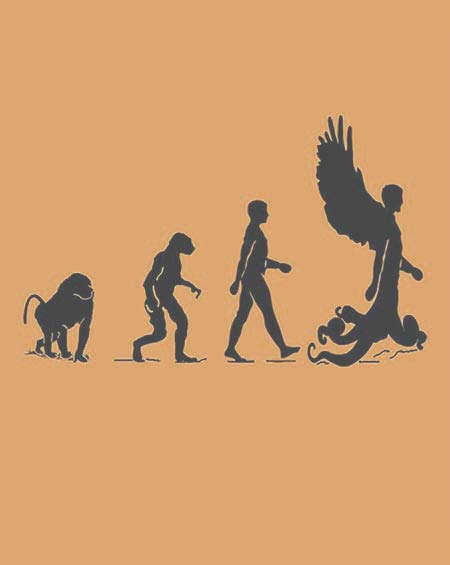I use the term human enhancement to mean any attempt to expand or alter human capabilities non-therapeutically —
meaning the goal is to improve human performance rather than to cure or minimise either disease or disability.
The cloning of humans is on most of the lists of things to worry about from Science,
along with behaviour control, genetic engineering, transplanted heads, computer poetry
and the unrestrained growth of plastic flowers.
Plastic Flowers
March 16, 2013
Human Enhancement
A flourishing human life is not lived with an ageless body or an untroubled soul,
but rather in rhythmed time, mindful of its limits, appreciative of each season,
and filled with those intimate human relations that are ours only because we are born,
age, replace ourselves, decline, and die — and we know it.
— Beyond Therapy: Biotechnology and the Pursuit of Human Happiness
from President Bush’s Council on Bioethics, 2003, headed by Leon R Kass
But does an ageless body or an untroubled soul really prevent life from flourishing?
Methods of Enhancement
Enhancements can be accomplished in various ways:
Drugs
- performance drugs
- mood-altering drugs
- nootropic drugs
These categories have blurred edges. Performance drugs would include methylphenidate (for studying), propranolol (for performance anxiety), steroids (for building muscles), modafinil (for alertness, wakefulness, focus). I suppose weight-loss drugs enhance “performance”. Sildenafil citrate, though sometimes taken to correct erectile dysfunction, is often used as a performance enhancer. Mood-altering drugs include selective serotonin reuptake inhibitors (such as paroxetine and fluoxetine) taken to stave off unhappiness (rather than to combatting the disability of depression), bremelanotide (which not only tans the skin but increases sexual appetite), metyrapone (which dulls the sting of painful memories), alcohol (in moderation, another sting-duller and anxiety-reducer), and marijuana. Nootropic drugs improve learning and memory. This includes methylphenidate, modafinil, and the reversible acetylcholinesterase inhibitor, donepezil (which reduces response time).
- entheogenic drugs
- nanomedicine
Entheogenics include psychoactive drugs and/or those that induce a “spiritual” state. Nanomedicine ranges from the medical applications of nanomaterials, to nanoelectronic biosensors. This technology is mainly under development.
Surgery
- gene modification or elimination
- cosmetic surgery (including body modification)
Gene modification is the enhancement tool of the future, but it’s still early days. Epigenetic modification may perhaps mature first, meaning turning already-existing genes off when on, or vice versa. Cosmetic surgery includes body modifications by piercings, cuts and dyes.
Appliances
- implements
- implanted chips
- prosthetics
By implements, I mean tools, weapons, robotics, canes, cars, parachutes, space suits, and the like. Innumerable implements enhance human capabilities in one way or another — far too many to even list, and since before recorded history, so I won’t be mentioning them much. Implantable computer chips (neurocognitive prostheses) could increase memory storage, improve memory search, translate language on the fly, or supply immediate procedural knowledge. They will allow the development of brain-computer interfaces. (The pilot of a JSF F-35 Lightning II could become his plane.) Most prosthetics are currently used therapeutically, but exoskeletons (for example) could enhance a soldier’s strength and speed. Postmen, couriers, deliverymen, and others could walk faster and carry more.
Gastric bands are internal prosthetics that aid weight loss.
One method of applying enhancement technologies is the attempt to make a person as good as he could possibly have been had his life unfolded under optimal conditions (his “baseline functionality” can be restored). Something in life has held him back (being compounded, perhaps, by the ravages of advancing age): lack of inheritance, poor parenting, delayed opportunity, or physical and/or mental irregularities. Technologies intended to effect a near-optimal standard state include hair transplants, hair dye, hairpieces, certain implants and prostheses, weight-loss surgery, various age-renewal procedures, drugs to invigorate / soothe / regulate. One thing should be mentioned: no normal person becomes a genius over a short period from using nootropics. Success requires basic, well-stocked mental equipment to begin with. Embedded computer parts and/or gene tweaks will likely be prerequisites if augmented mental capabilities are intended to stick around permanently.
But there’s more: A person can become better than he could ever have been naturally. This can mean he’s more beautiful or handsome via plastic surgery, has perfect teeth from expert dentistry, and has discreet prosthetics of various sorts. It can also mean he has increased athletic ability (from chemicals or devices), a pleasing personality (from mood-altering drugs), night vision (from a bionic implant), blood scrubbed of disease germs (from nanoparticles), and a non-detectable computer interface implant.
And that’s only the beginning.
“Cybernetics” comes from a Greek word meaning “the art of steering” and is meant to evoke the rich interaction of goals, predictions, actions, feedback, and response in systems of all kinds. A “cyber” is a navigator. The word “cyborg” is short for “cybernetic organism,” a being with both organic and cybernetic parts. Fictional cyborgs are portrayed as a synthesis of organic and synthetic parts, and frequently pose questions about the differences between humans and machines (one is concerned with morality, free will, and empathy while the other is not). They may be represented as visibly mechanical (for example the Cybermen in Doctor Who or the Borg from Star Trek) or as virtually indistinguishable from humans (the Terminators from the Terminator films). The 1970s television series “The Six Million Dollar Man” featured one of the most famous fictional cyborgs, referred to as a bionic man; the series was based on a novel by Martin Caidin entitled Cyborg. Fictional cyborgs capitalise on human contempt for over-dependence on technology, particularly when used for war (military forms have inbuilt weapons, among other things) or in ways that call free will into question.
Cyborg physical or mental abilities are expected to far exceed those of mere humans.
What’s Wrong with Human Enhancement?
In general, people feel others will have access to enhancement technologies and will reap rewards from them where they do not and cannot. Some people are unwilling to assume the risks; others can’t afford the costs. Hidden enhancements give unfair advantage in competitions, including athletics, auditions of all kinds, examinations, and beauty contests.
What types and classes of enhancements will be regulated? How heavily? And by whom? Will insurance pay any of the cost?
Personal Considerations
The negative personal impacts of enhancement technologies are legion: allergic reactions, personality changes, depression, botched surgery, even unexpected death. Botox can leave a face expressionless. Chemical peels can result in serious infections. Steroids impact fertility. Erythropoietin, or EPO (a glycoprotein hormone that controls red blood cell production) improves endurance but increases stroke risk. Modafinil enhances alertness on some tasks but compromises performance on others and can make users nervous, anxious, and bring on headaches. Beta blockers can cause drowsiness, fatigue and wheezing. Ritalin, Adderall and other such drugs can cause headaches, insomnia, stunted growth, and loss of appetite. One Stanford University study found that while low doses of acetylcholinesterase inhibitor (which occurs naturally in venoms and poisons) improves the performance of pilots, side effects include both dizziness and vomiting.
Due to risks, many human enhancement technologies have an inbuilt self-limit on their degree of public acceptance.
Evaluations of various enhancements are generally based on short-term studies (for the newer technologies, new is all there is). Researchers are often unable to recognise early stages of deleterious effects as evidenced by the fact that the majority of efficacious weight-loss drugs have eventually been removed from sale. Sibutramine (Meridia) was withdrawn in multiple countries by 2010; rimonabant (under various trade names) was suspended in 2008; amphetamine (Benzedrine) was banned by the US Congress in 1979. Orlistat (Xenical), which blocks fat absorption remains — but it can cause rapid-onset diarrhœa.
Societal Considerations
Deontology is the study of moral obligation. Deontologists are concerned with the effect enhancement technologies may have on our understanding of human nature and of ourselves as individuals. Gains in human ability mean trade-offs with those capacities our ancestors selected for us.
The lives of everyone (those who choose to enhance as well as those who don’t) will be affected by living in a society where enhancement is widespread. The freedom not to enhance could be difficult to maintain in a society where usage is expected. The distinction between normal and being diseased begins to blur. Being aged, overweight, sexually underperforming, with hair loss, shyness, tiredness, and being too short have already been redefined as abnormal. More will follow because while the desire to alter our mental states and to extend our youthful strength and appearance as long as we can may begin modestly, our desires can become raging torrents as humankind becomes more technically skilled.
Where will it lead?
Today, the word “depression” has almost entirely eclipsed the concept of unhappiness: few are unhappy, though many are depressed. This implies that a dissatisfaction with life is pathological, a medical condition. Should a person’s mood really be freed from correlation with the way he is living his life? Reward should not be completely disconnected from conduct. Will we no longer cause our own misery, learn from it, and then change? (Will we just up our dosage instead?) The pangs of conscience, the despondencies of failure, the reveries of grief, even personality itself might all become viewed as pathologies needing treatment.
Privacy issues are a consideration for implantable computer-brain interfaces as interactions with other people may be recorded without knowledge and consent.
Athletes who compete — not just through personal effort but also via biological enhancements — seem more machine-like. Their accomplishments become less admirable as they become more impressive. The line between person and equipment becomes fuzzy. One professional musician estimates that ¾ of musicians she knows use propranolol (Inderal) at least occasionally. Musicians say this kind of drug use is all above board — but does it reduce expression of feeling through music?
In the future, a DNA reading of an embryo’s capabilities and skills would show the career he’s most likely best suited for. As industries foresee future need for certain types of workers, parents may be willing to commit a child’s future in return for help with expenses. Parents would relinquish little Johnny to the company at age 12 or thereabouts so that his specialist training and tweaking can start. The family will stay in touch via technology, of course. Perhaps children will one day be bred (rather than merely selected) for particular jobs. If parents intervene directly to enhance a child for commercial reasons, they become more like breeders or manufacturers.
Innovations that save time and effort enable us to be more productive and to have potentially more worthy goals. But it may also undermine the value and dignity of hard work. Chemically changing behaviour and innate ability to a notable extent could threaten our notions of personhood — and require the attainment of a universally-accepted norm of fitness at the expense of a safe level of human diversity. (For example, the distractibility of people with ADD makes them especially alert to changes in their environment — good people to choose for crew on boats or spaceships.)
What’s Right with Human Enhancement?
The ethics and desirability of “enhancement prosthetics” have been debated; their proponents include the transhumanist movement, with its belief that new technologies can assist the human race in developing beyond its present, normative limitations on speed, strength, endurance, and intelligence. With new technologies we can work more comfortably in extreme conditions, work much further into old age, completely change careers in mid-life, still be working our way upward in later years, and keep ourselves more attractive for more decades of our lives, thus allowing us additional attempts at finding the ideal job or perfect spouse.
It isn’t a good thing for human evolution to stop, so of course our future will be new and strange. Perhaps the cycle of a single human life will slow to allow time for appropriate “programmes” to be installed that lead up to appropriate maturity that will allow for important goals to be completed before retirement. That sounds positive.
Taken altogether, human enhancement seems like a normal phase of human evolution aimed to reduce group friction. It appears we’ll be bringing all humankind up to a certain basic level.
Growing numbers of people use a broadening range of enhancements to better their bodies and minds. Many obtain what they desire from illicit markets, meaning some of them risk serious harm. This problem is magnified by the growing number of untested, banned, or adulterated drugs, foods, herbs, implants, and cosmetic products that contain hidden active substances. Often, little is known about the risks of these untested minerals or chemicals. People turn to these sources because of huge pressure to improve, fit in, compete, and cope. The globalisation of communication plays a critical role in the speed of fitness-fad spread, making control difficult. (Existing legal and regulatory systems are largely national, not global.)
Existing legal and regulatory frameworks aren’t designed to address “enhancement” questions nor regulate their supply to the public. Should clinicians prescribe drugs and implants if the alternative is that patients merely turn to illicit markets? It was once thought that the development of “synthetic sunshine” (firelights, lamplight and electric light) would cause people to be forced to work through the night. The response then wasn’t to ban artificial light but to regulate working hours.
The same will likely be true for enhancements.
EVERYONE already enhances themselves to some degree, but some people are naturally more cautious than others.
Egalitarianism is a libertarian ideal but it’s never been human reality.
Enhancement technologies can move humans closer to that ideal or farther away.
Which one prevails may not even be within our control.
Yet life will still flourish — it always has.
Has Some Government Secretly Been Cloning?
In fiction and folklore, a doppelgänger (German, literally a “double goer”) is a paranormal double of a living person. It also describes the sensation of having glimpsed oneself in peripheral vision, in a position where there is no chance that it could have been a reflection. Doppelgängers often are perceived as a sinister form of bilocation and are regarded by some to be harbingers of bad luck. In some traditions, a doppelgänger seen by a person’s friends or relatives portends illness or danger, while seeing one’s own doppelgänger is said to be an omen of death. Recent scientific experimentation duplicates several doppelgänger effects when electrical stimulation is applied to the left temporoparietal junction of the brain of a patient. In the contemporary vernacular of some English speakers, the word may be found used simplistically to identify any lookalike persons, without regard to the supernaturalness and fundamental doubling intended in the meaning of the word.
Photographer François Brunelle of Montréal, Canada has taken about 200 photos of lookalike pairs who are not related in any way and don’t even know each other.
10 million pairs of identical twins are alive today. In other words, to be an identical twin is not all that strange. All identical twins begin as a single fertilised egg. This zygote, a single cell, begins to multiply and becomes a blastocyst, a blob of about 100 cells, which becomes the fœtus. It’s surrounded by a circle of other cells, which becomes the placenta. In the case of identical twins the blastocyst splits and grows into 2 genetically identical infants. But having identical genes doesn’t make you totally identical as identical twins can be up to 12% different. Therefore, the term “identical” has been replaced by “monozygotic.” The difference is caused by epigenetics, which is the set of modifications to our genetic material that change the ways genes are switched on or off, but which don’t alter the genes themselves. Genes are rows of base pairs within DNA that provide the code for the production of proteins within the cell. Genes in liver cells express proteins that do the work of the liver; genes in skin cells or eye cells express proteins that do the work of the skin or the eye. So, what causes certain genes to turn on in one cell and stay off in another? Why don’t we grow eyes on our fingertips? After all, each cell in our body contains our entire genome.
The answer is that some genes code for proteins whose job it is to lie down on a gene and keep it turned off. Other genes code for proteins whose job it is to enhance transcription — the first step in making a protein. This regulation of gene expression is epigenetic. The epigenetic process is influenced by chance and by the environment and produces what is known as clone discordance. Think of DNA as a script, rather than a template. With a template you stamp out identical gingerbread cookies. With the same script you can make two very different movies.
The causes of monozygotic twinning are generally unknown and unidentified. Technically it’s a malfunction of the normal development process. There’s no hereditary trait that influences a predisposition to having identical twins — they don’t run in families. Identical twins represent about a third of all twins. Birth rate statistics for identical twins have remained stable over the years, despite the overall increase in twins and multiples since the late 1980’s. Identical twinning is not generally influenced by fertility-enhancing treatments like drugs or in-vitro. Birth rates for identical twins are consistent across populations; it’s the same regardless of race, geography or maternal age.
Researchers suspect that as many as 1 in 8 pregnancies start out as multiples, but only a single fœtus is brought to full term, because the other has died very early in the pregnancy and has not been detected or recorded. Early obstetric ultrasonography exams sometimes reveal an “extra” fœtus, which fails to develop and instead disintegrates and vanishes. This is known as vanishing twin syndrome. A chimera is an ordinary person or animal except that some of their parts actually came from their twin or from the mother. A chimera may arise either from monozygotic twin fœtuses (where it would be impossible to detect), or from dizygotic fœtuses, which can be identified by chromosomal comparisons from various parts of the body. The number of cells derived from each fœtus can vary from one part of the body to another, and often leads to characteristic mosaicism skin colouration in human chimeras. A chimera may be intersex, composed of cells from a male twin and a female twin. In one case DNA tests determined that a woman, mystifyingly, was not the mother of 2 of her 3 children; the mother was found to be a chimera of two fused fœtuses herself. Those of her cells used in the DNA test came from one of those fused twins, while two of her children developed from eggs contributed by the other fused twin. (Does that make them half-siblings, then?)
Intergenerational Twins
German photographer Frauke Theilking’s photo project called Generation observes the similarities and differences between parent and child. Each photo pairs a mother/daughter or father/son combo side by side. Devoid of an elaborate background, Theilking’s photos focus the viewer’s attention on the subjects, who themselves aren’t wearing any distracting clothing. For a lot of the images, it feels like looking at a split-screen of the same person at different stages in their life.
Time Travel?
Which category in high school did you most identified with: Jocks, Populars, Brains, Normals, Druggie/Toughs, Outcasts, or None? The kids who were identified by their cohorts as Druggies, Normals, or Jocks tended to see themselves in the same way. Of the kids their cohorts had thought were popular, just 27% in one study and 37% in another indicated that they had viewed themselves as campus celebrities. Most kids were inclined to view themselves either as Normal or None.
 Animals
Animals Animation
Animation Art of Playing Cards
Art of Playing Cards Drugs
Drugs Education
Education Environment
Environment Flying
Flying History
History Humour
Humour Immigration
Immigration Info/Tech
Info/Tech Intellectual/Entertaining
Intellectual/Entertaining Lifestyles
Lifestyles Men
Men Money/Politics/Law
Money/Politics/Law New Jersey
New Jersey Odds and Oddities
Odds and Oddities Older & Under
Older & Under Photography
Photography Prisons
Prisons Relationships
Relationships Science
Science Social/Cultural
Social/Cultural Terrorism
Terrorism Wellington
Wellington Working
Working Zero Return Investment
Zero Return Investment